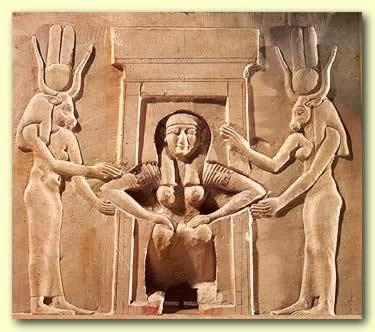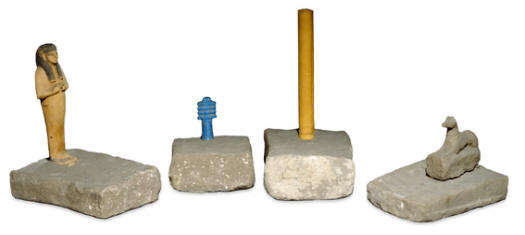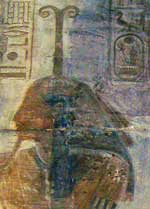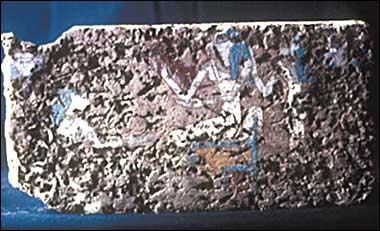Ritual is how we DO religion.
And to do ritual, we perform a set of prescribed actions and, usually, words. Our rite may be something as simple as sitting quietly and counting our breaths or lighting a candle. Or it may be something as elaborate as an initiation ritual.
Yet just doing a set of actions and reciting specific words is not enough. Another vital component must be present in order to transform the actions and words from rote performance to real participation in the sacred. There must also be an psychospiritual component to our ritual. When the transformation from performance to participation is successful, we are taking part in sacred magic—a term particularly appropriate when it comes to Isis, She Who is Goddess of Magic par excellence. And because She is Lady of Magic—in Egyptian, Iset Nebet Hekau—I consider all Isiac ritual acts to be acts of sacred magic.
This is one of the reasons I was happy—thrilled, actually—to see the recent review of Offering to Isis by Foolish Fish. I was pleased because the reviewer had noticed that I included the ritual visualizations in the dromena, that is, the part of the rite that describes the ritual actions. Dromena might include things like purifying by sprinkling water, consecration with incense, walking a protective circle around your temple, or raising your arms in the Sign of the Wings of Isis—in addition to the breath-counting or candle-lighting already mentioned.
While the physical acts of ritual are important—and sometimes taking the action itself can help trigger the magical mindset when the dromena have been practiced extensively, it is the state of our minds, souls, and spirits—the “magical mindset,” if you will—that makes the ritual work. And by work, I mean that it connects us with the spiritual world, helps us communicate that which we wish to communicate, and helps us transform ourselves and/or our world.
What “mindset” conditions facilitate successful magic? Usually, these are a bit different for each person. Yet, I do think there are commonalities to look for.
For instance, if we can increase our sense of openness, both physically and spiritually, this will help us increase our magical perception. A feeling of expansion—in the heart, in the mind, in the spirit—all help us open ourselves to the Divine. We need to “uncramp” ourselves, loosening body, soul, and spirit. (That’s why we are so often advised to leave the cares of the outside world at the door of our ritual space.) What’s more, if we can cultivate in ourselves a feeling of expectancy and anticipation, we will be helping to create the right conditions for magic to happen.

We have the ability to attune our hearts and minds, allowing ourselves to enter into these expanded states. And when we do, the result is often a sense of connectedness. When we can take down our walls and remove our masks, we allow ourselves to become more aware of the connections that inevitably exist—connection with the natural world around us, with the symbols of the rite, with the other people who may be in ritual with us. Importantly, we can better perceive our connection with the unseen realms—and with Isis Herself.
This can be easier to describe than to achieve.
On the other hand, I know people—adepts of one tradition or another—who can tune into their magical mindset almost instantly. That’s because they’ve been practicing for many years. Most of us, most of the time, need to work at it in order to transform our everyday mindset into the magical mindset.
One way to do this is through visualization. Visualization is “seeing with the mind’s eye.” Visualization is creative imagination. And it is a powerful magical tool. In the Hermetica, the great Hermetic teacher Hermes Trismegistos (aka the Magician God Thoth) explains, “coming to be is nothing but imagination.” And you might recall that “coming into being” is one of the most common ways ancient Egyptian texts describe the creation of something new. “And so, X came into being,” texts say.
Many people are familiar with guided meditation, in which you try to imagine or “see” the scenes your guide is describing, yet you have your own reactions and experiences within the parameters of the guided visualization. But we can guide our own visualizations, too. I don’t mean just having our own free-wheeling reactions to whatever energy we’ve invoked, but actually guiding what happens and precisely imagining the energies invoked. This is not cheating; indeed, it is a key part of creating your magical mindset.
For some, visualization can be difficult. If that is the case for you, don’t be concerned. You may sense the unmanifest realms in other ways: hearing words, sensing things or simply “having a feeling.” Practice describing your perceptions to yourself in ways that make sense to you.
Nevertheless, many, even most, of us can teach ourselves to visualize. I’m probably dating myself here, but I taught myself to visualize using a book called the Silva Mind Control Method. While there are other aspects to the Silva method, to learn visualization, for 30 days in a row, you visualize an apple, each day adding more and more “reality” and sensual perceptions to the visualization. It worked for me.
But if you’re one who simply does not work that way, I’d suggest making your rituals symbol-rich. For instance, if you’re invoking the elements, have symbols of each element in the corresponding quarter of your altar—and know what the symbols mean; study them, read about them. Instead of visualizing, you can physically see and mentally contemplate the symbol, thinking about its meaning as you call-in each element. And don’t forget that words are symbols, too. The words of the ritual, as well as evocative poetry, can help transport us into the magical mindset.
For those who do visualize or would like to, I’ll share an example of how it can be used in ritual.
Let’s say we want to create those conditions of openness, expansion, and expectancy we talked about. This is precisely the purpose of the ritual of “The Opening of the Ways” in Isis Magic. It’s an all-purpose rite intended to create sacred space for communion with the Goddess, for meditation, for offering, or for any other act of sacred magic. In this ritual, we think of our own aura as a temple into which we are inviting the Presence of Isis. We visualize opening each of the directions (or “Ways”) to Isis, so that the energy and Presence of the Goddess can enter our temple.
Here’s what I often visualize:
In each direction (east, west, south, north, above, below, and heart-center) I imagine a pair of Egyptian pillars with translucent curtains closed between them. As I open each of the Ways, I will pull aside the curtains to reveal a scene beyond them.
For instance, as my physical body stands facing east with my arms before me, palms together, I prepare to Open the Ways to Isis of the East, the Lady of the Breath of Life, by making the Sign of the Opening of the Shrine.
In my mind, I see the two sculpted, Egyptian pillars, pale-yellow, sandstone colored. I sense that if I were to really look closely at them, I would see Egyptian hieroglyphs showing sails and fans and images of Deities of the Winds. But I need not always do that; for now, I simply see the pillars and the closed curtains before me. With my physical arms in front of me, I feel a bit of tension in my shoulders and arms and know that I will expend real energy when I open those curtains.
I say, “Let the Shrine of the East be opened unto Isis, only Isis,” and I open my arms out—wide—as I vibrate Her name: Iset Nef. I am sure to make this gesture fully in the physical so that I can take a deep breath and feel the openness in my own chest. At the same time, I imagine my hands pulling the curtains to the right and left so that I can now see out to the scene that lies between them.
I “see” that I am standing on a cliff where a cool, morning breeze blows softly as the sun rises in the dawning light. I breathe deeply, understanding that Isis of the Air is entering into my temple, into me, with each breath. I breathe the breath of Isis Herself, as She comes to me, comes to me. By now, I will usually feel something in my body, a tingle of energy, as the magical connection is made and I sense the Presence of Isis of the Air, the Lady of the Winds, the Queen of the Breath of Life.
I repeat the same actions, but with different visualizations and Goddess names, at each of the Quarters, above me, below me, and at my heart. (If you want to try it, the ritual is at the link above.)
When I’ve completed these ritual actions and words, along with the visualizations, I should be well on my way to achieving my magical mindset. I will feel much more open, expanded, expectant, and connected, ready to commune with Isis or do any other work of sacred magic.
Even now, just describing it to you, I am almost, almost, almost there.



















































































































































































